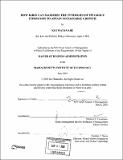How Kirin can maximize the synergies of its group companies to attain sustainable growth
Author(s)
Watanabe, Kei, M.B.A. Sloan School of Management
DownloadFull printable version (5.300Mb)
Other Contributors
Sloan School of Management.
Advisor
Michael A. Cusumano.
Terms of use
Metadata
Show full item recordAbstract
At the end of twentieth century, Kirin Brewery Co. began a strategic move to break out of the saturated domestic market by adopting an international orientation and diversification effort to become a leading company in the Asia and Oceania markets. Following consolidation of its distribution channels and plant networks in the target region through successful strategic alliances with Lion Nathan Ltd. and Sun Miguel Corporation, Kirin Group has now grown into a large corporate group. However, history is full of examples of food/beverage companies that encountered difficulties achieving sustainable growth after early experiences of rocketing sales at takeoff-even though many such companies know that the key to success is taking advantage of group synergies. This thesis identifies a corporate strategy for Kirin that can be realized by creating two kinds of synergies of resource sharing in various phases of the value chain in order to upgrade Kirin Group's set of resources, and a synergy in the company's strategic thrusts. My research found that sharing intangible resources could play an important role in attaining architectural innovation. (cont.) Each resource sharing idea builds on three strategic thrusts that could counter the external environment in the target geographic region. I address how to create synergies across multiple positive feedback loops that consist of the three strategic thrusts as a virtuous cycle. I stress that kicking on path dependence of the multiple loops could snowball Kirin's growth. Then I discuss ways to shift a leading organization in order to achieve a new strategy. Possible methods for managing this proposed organizational change include invigorating group dynamics by managing the Communication Loop, Career Anchor, and Creative Tension; activating organization dynamics by controlling Informal Network, Inquiry and Advocacy; and treating deep-rooted organizational culture by tracing the steps of each individual's Ladder of Inference. I argue that upgrading Kirin's resources to enable it to compete through sharing intangible resources, firing up the company's development engines to encourage growth by linking multiple positive feedbacks, and reinforcing the organization by invigorating human resources, will enable Kirin Group to build strong customer bonding through Total Customer Solution. (cont.) The central focus of Kirin's corporate strategy in this thesis is its alcohol business, which accounts for 74% of sales and 75% of operating income within the alcohol and soft drink business in 2004. The market scope is the off-premise market in which opportunities and threats grow larger as global retailers continue to expand their reach beyond their own national borders.
Description
Thesis (M.B.A.)--Massachusetts Institute of Technology, Sloan School of Management, 2005. Includes bibliographical references (leaves 105-109).
Date issued
2005Department
Sloan School of ManagementPublisher
Massachusetts Institute of Technology
Keywords
Sloan School of Management.